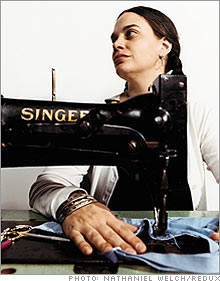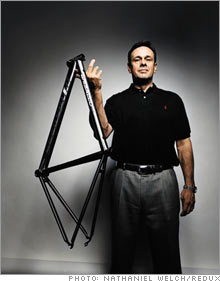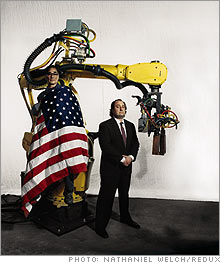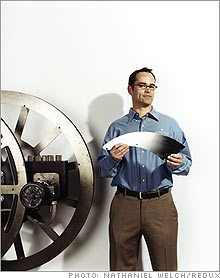With a little innovation, who needs outsourcing?Gentler scalpels? Floats that never fail? Delivered yesterday? No problem! That's why small U.S. manufacturers are on the rise.(FSB Magazine) -- The shop floor at specialty blades smells like machine oil, but nary a drop of the greasy glop can be seen. The bright, airy room is so quiet that the few scattered workers chat between stations without raising their voices. The robotic cutting machines gleam, the racks on the metal shelves are neatly labeled, the floor is pristine. Since when does the gritty world of small manufacturing look like this? In its factory nestled in the foothills of the Blue Ridge Mountains in Staunton, Va., Specialty (specialtyblades.com) manufactures millions of blades each year, ranging from scalpels to the serrated versions that cut gas-pump receipts. The profitable company, founded in 1985, expects to see sales of $20 million this year, up 16 percent over 2006. "We are very much a growth company," says CEO Peter Harris, 38.
Harris is not alone. True, Detroit is in a slump and the entire manufacturing sector generated just 12.1 percent of U.S. GDP in 2006, compared with 17.5 percent in 1986. On top of that, manufacturing employment dropped from 17.2 million in 1996 to just over 14 million as of last year. But manufacturing is showing distinct signs of life at the smaller end of the scale. Between 2000 and 2005 there was a 67 percent increase in manufacturing startups, according to a survey by the Kauffman Foundation (kauffman.org). That's particularly significant when you consider that fully 70 percent of all U.S. manufacturers have fewer than 20 employees. Add it all up, and small-business owners can take some credit for the increase in overall manufacturing sales, which rose by 20 percent between 2002 and 2006, according to census data. What's driving this resurgence? One word: innovation. Not long ago the default answer to sagging manufacturing profits was to slash labor costs by moving the factory overseas. But many manufacturers now realize that offshoring doesn't always make sense. After decades of downsizing and capital investment, labor today accounts for just 5 percent to 15 percent of total U.S. manufacturing costs, according to Susan Helper, professor of economic development at Case Western Reserve University's Weatherhead School of Management. Offshore risks include uneven quality control, communication breakdowns because of language barriers, political upheaval, and high transportation costs, not to mention the possibility that the low-cost factory in Guangzhou will steal your intellectual property to build a rival product. The best small American manufacturers are finding ways to compete on a global scale. They are applying creative tweaks to their manufacturing processes, improving efficiency and lowering production costs. They're relying on theories and technologies that were once the exclusive province of multinationals: rapid prototyping, lean manufacturing, efficient supply chain management and better quality control. It's all about innovation, and in this U.S. entrepreneurs excel. The best small manufacturers are adept at listening to their clients and finding creative solutions to their needs. The engineers at Specialty Blades design precision cutting devices for varied, usually custom applications. On one recent project they worked closely with a medical-device company to develop a combination scalpel and stapler that slices tissue very neatly close to the staples. The result is a less traumatic procedure, so the patient recovers more quickly. A healthier patient can go home a day early, which makes the hospital happy because squeezing in extra surgical procedures is more profitable than housing patients in recovery. Specialty's clients are willing to pay premium prices for that level of industry-specific expertise. It's no accident that Specialty earns its highest margins on blades produced in Virginia, although the company sources some low-end products from Shanghai, where it also has a sales office. "If you sell a product that can easily be made today in China, you should expect to absolutely go out of business at light speed," says Harris. "So we focus on products where much of the value comes from the engineering of the specific solution rather than the production cost of the component." Rapid Deployment In the hypercompetitive world of modern manufacturing, success often hinges on how fast a company can bring new products to market. Rapid prototyping is a key aspect of this process and one in which many small U.S. manufacturers excel. S&S Cycle (sscycle.com) builds high-performance motorcycle engines and after-market engine components. Launched in 1958, S&S operates two Wisconsin factories, in LaCrosse and Viola. In 2000 the company invested heavily in cutting-edge manufacturing technology, purchasing two rapid-prototyping machines that create plastic and wax parts. The new technology has slashed production time at the 350-employee company. Before, S&S sent drawings to a foundry that created a mold and then cast a prototype part. S&S would test the part, make adjustments, resubmit new drawings, and wait for another prototype. "If you wanted to make a throttle body, for example, the turnaround time could be weeks," explains president Brett Smith, 35. "Now, with the AutoCAD software and the prototype machine, we can have that part in 24 hours." S&S can now create a plastic air-intake tract, for example, and immediately put the sample part on the engine to check the fit. The part then goes to a foundry, which uses it to make the mold and cast a metal prototype. Developing complex items, such as a crankcase, used to take up to two years from concept to inventoried parts. The new technology has compressed that cycle to as little as six months and has increased productivity by 50 percent. Smith says revenues at his profitable company have doubled over the past seven years, but won't release the numbers. Striving For Perfection Although speed is important, it won't help sell shoddy goods. That's why smart U.S. companies focus relentlessly on quality control. Quality Float Works (metalfloat.com) is not only winning bids against Asian manufacturers but also shipping product to China, Vietnam and eight other countries. The Schaumberg, Ill., factory makes pump floats, the hollow metal balls used to level the amount of liquid flowing through a pump. The company's floats can be found in everything from automatic coffee dispensers to the pumps that helped drain water from New Orleans after Hurricane Katrina. In 2006 sales rose 25 percent, to $2.2 million. Quality Float follows stringent ISO 9002 and other manufacturing standards. The firm tests the eyesight of its workers regularly and inspects each part "at least three times before it goes out the door," says CEO Sandra Westlund-Deenihan, whose grandfather founded the family business in 1915 and who describes her age as "forever 21." Westlund-Deenihan's attention to detail has paid off over the years. The last time a Quality client returned a part for a manufacturing defect was in 1992, and that was only because the client had provided an unclear blueprint specification. |
Sponsors
|




